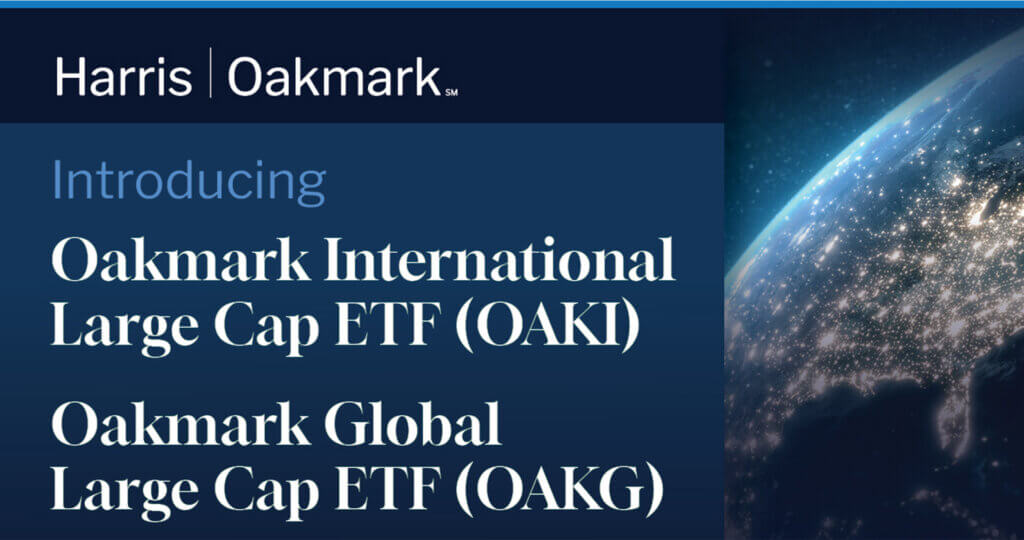Oakmark Equity and Income Fund – Investor Class
Average Annual Total Returns 03/31/20
Since Inception 11/01/95 8.67%
10-year 4.65%
5-year 0.48%
1-year -14.48%
3-month -22.03%
Gross Expense Ratio as of 09/30/19 was 0.91%
Net Expense Ratio as of 09/30/19 was 0.81%
Past performance is no guarantee of future results. The performance data quoted represents past performance. Current performance may be lower or higher than the performance data quoted. The investment return and principal value vary so that an investor’s shares when redeemed may be worth more or less than the original cost. To obtain the most recent month-end performance data, view it here.
The Pandemic Market
Fastest decline into a bear market ever. Shortest time spent in a bear market ever. Eight consecutive days when the market either rose or fell by over 4%. Largest one-day stock market gain since 1933. Second-largest one-day drop ever. A collapse in the price of oil. Remarkable individual stock volatility. Growth outperforms value by a near-record amount. Small- and mid-cap issues suffer major price declines, far in excess of large caps. The U.S. registers the largest number of weekly unemployment claims ever by a factor of more than three times. The Federal Reserve reduces the Fed funds rate to 0%. Congress passes an economic stimulus package of more than $2 trillion. We are truly living and investing in what we believe is an extraordinary time.
History teaches us that it takes time for the market to stabilize and regain its footing after such an amazing disruption. We believe that our proper course of action in such a time is to attempt to seize moments of extreme price dislocation and to improve the Fund’s tax position for our taxable clients. To that end, we have been fairly active. Market turmoil has affected the Fund’s asset allocation, and we are working to realign the portfolio appropriately. Our most important advice to clients during this tumultuous time is to take the same action we are—rebalance. If two months ago your asset allocation was appropriate for your circumstances, you probably need to act to return to that allocation.
The Oakmark Equity and Income Fund declined 22% in the quarter, which contrasts to a 13% loss for the Lipper Balanced Fund Index, the Fund’s performance benchmark. Value stocks’ severe underperformance during the downturn was the main reason for this shortfall. For the fiscal six months, the Fund showed a loss of 17%, compared to 8% for the Lipper Index. The quarter’s decline has dented the Fund’s return since inception, but we are still pleased to report that it is 8.7%, while the corresponding return for the Lipper Index is 6.3%.
The only contributors to portfolio return in the quarter were Regeneron Pharmaceuticals, Oracle (sold) and Zimmer Biomet, a new purchase discussed below. Bank of America, General Motors, TE Connectivity, Citigroup and Ally Financial detracted most. For the first six months of the Fund’s fiscal year, Regeneron, Charter Communications, UnitedHealth Group, Zimmer Biomet and Oracle were contributors, while General Motors, TE Connectivity, Ally Financial, Bank of America and Citigroup detracted most from return. The pandemic has caused investors to flee financial company stocks even though these companies have far stronger balance sheets than they had during the 2008 downturn. Combined with the extraordinary support that governments worldwide are throwing at the economy, these balance sheets should enable our financial holdings to fare well in this crisis.
Fixed Income Sector Review
In fixed income, the dizzying pace of developments stemming from the virus was remarkable. Corporate bond yields had been at an all-time low, underpinned by record unemployment and a benign growth outlook, but coronavirus concerns caused them to catapult to levels that implied a substantial U.S. corporate default cycle—greater than 20% by our estimation—and an imminent recession. Meanwhile, the Fed pivoted from voting on the merits of a 1.75% policy rate to dropping that same rate to 0% and announcing the largest monetary stimulus (~$4 trillion-$5 trillion) on record. Liquidity programs, like the Commercial Paper Funding Facility (CPFF), an artifact of the financial crisis, were dusted off and deployed alongside entirely new programs, such as the Primary Market Corporate Credit Facility (PMCCF). This was all in a matter of weeks. Despite the frenzy of market activity, we kept the Fund’s fixed income exposures relatively stable during the quarter. Coming into the period, our views that corporate credit valuations were priced close to perfection had the Fund aligned in shorter duration, non-cyclical corporates, which protected us well during the historical jump in credit spreads. In addition, the portfolio’s short-duration Treasury positioning helped dampen the overall portfolio volatility, but we missed out on the significant returns generated by longer dated government bonds during the period.
As we move forward, we see a compelling opportunity to trim our highest quality corporates, which have been relatively unscathed by the pandemic, and invest in securities whose issuers’ business values we believe will largely remain intact as we emerge from this crisis. This doesn’t go without a major caveat, however. Given the sudden stop to the economy, we are now hyper focused on companies’ liquidity runways over the next 12 months to ensure that they will be solvent enough to realize their longer term valuations. As for Treasurys, the Fund missed out on some return over the past several years by adhering to a short duration, but nevertheless, we remain convinced that maintaining a short duration is the correct policy. We view the asymmetrical downside returns longer out on the curve as quite possibly the most skewed risk-versus-reward profile investors are facing across any major asset class in the market today. Yes, all-time low rates could persist for some time as we deal with the economic fallout from the coronavirus. On the other hand, the unprecedented global stimulus efforts, combined with a peak in coronavirus case rates, could prompt a long overdue return to fundamentals. If, as a result, there is a stampede out of Treasurys that approaches the intensity of the stampede into them, rates will likely appreciate rapidly and long-duration investors could incur meaningful mark-to-market losses. In contrast to historical precedent, investors are now collecting close to zero in yield as they await which scenario will play out.
Equity Transaction Activity
The recent quarter’s extreme volatility afforded us many opportunities to try to upgrade the equity portfolio and increase tax efficiency. In other words, trading was active. We initiated three new equity holdings and eliminated five. Our first new purchase was actually a return to a previous holding, Reinsurance Group of America (RGA). RGA is primarily in the business of reinsuring life insurance contracts. When the coronavirus began to be understood as a worldwide pandemic, RGA’s share price collapsed to levels that, in our view, reflected a worst case scenario. Our discussions with management buttressed that assessment and we established a position at a price well below the company’s book value. For an insurance company, RGA maintains an unusually conservative balance sheet and an investment portfolio with relatively few equities. We also like the company’s management team, most of whom were in place when we last owned the stock three years ago.
Our second new purchase was Thor, a manufacturer of towable trailers and motorized recreational vehicles. The company controls the largest market share in this industry, followed by Warren Buffett’s Berkshire Hathaway-owned Forest River in the second position and Winnebago at a distant third. Although some recreational industry products have struggled to penetrate the millennial and Generation-X markets, RVs have proven to be an exception. In fact, recent surveys show that the average age of RV owners is getting younger. In addition, the higher proportion of sport utility vehicles on the road today also benefits Thor, since most of these vehicles come outfitted with towing capability. Finally, camping continues to increase in popularity and RVs are the choice for many campers. We have followed the company for many years and respect its management team considerably. Impressively, Thor has never experienced a loss year, despite the cyclical nature of its business. We purchased the stock during the quarter at a low multiple of our estimate of trend earnings.
The third new purchase was Zimmer Biomet Holdings, the worldwide leader in orthopedic implements. The rationale for this purchase is unusually simple and coronavirus derived. As the world focuses on treating individuals infected with the virus, hospitals have postponed or canceled elective procedures, such as knee replacements. This development caused Zimmer stock to drop precipitously to levels that we find quite attractive. In normal times, joint replacement surgery is one of the most frequent Medicare procedures, and the aging Baby Boom generation makes it likely that these procedures will only become more common. (The author of this section of the report has had both knees replaced and can recommend the procedure.) We believe that most of these postponed procedures will eventually take place, though this is obviously dependent on the healthcare system first controlling the coronavirus. We like Zimmer’s management team and expect the company’s reenergized new product development to be fruitful.
We eliminated our holdings in American Airlines, Diamondback Energy, EOG Resources, Oracle and WESCO International. All but Oracle produced tax losses that were used to offset previously taken capital gains. The pandemic has crushed demand for travel and American Airlines shares have suffered greatly. The oil price war between Saudi Arabia and Russia began just as the pandemic was developing, and the combination of economic slowdown and price war has impaired the prospects of U.S. energy companies, including Diamondback and EOG. Lastly, WESCO management may have committed to the most unfortunate transaction in the current economic and health crisis. The company engaged in an acquisition battle for Anixter, an electronics distributor, becoming the dubious winner of this battle in mid-January. This is a large deal for WESCO, requiring the issuance of shares and significant debt. As market turbulence increased in March, investors fled highly leveraged companies, including WESCO. Finally, we sold Oracle to accommodate purchases of more attractive issues.
Hello/Goodbye
With this report we welcome Adam Abbas, leader of our firm’s fixed income team, as a co-manager of the Equity and Income Fund. Adam replaces Edward Wojciechowski, who has ably served as Fund co-manager for the past seven years. When Edward joined the team, he was Harris Associates’ director of fixed income. Since then, he has moved on to different responsibilities. Although Edward has stepped down as a co-manager, we will continue to draw upon his investing acumen. Adam has served as a fixed income portfolio manager and analyst at several other firms. He joined Harris in 2019. Adam penned the “Fixed Income” section of this report. We look forward to his contributions to the Fund’s success.
As always, we thank our fellow shareholders for investing in the Equity and Income Fund.
The securities mentioned above comprise the following preliminary percentages of the Oakmark Equity and Income Fund’s total net assets as of 03/31/20: Ally Financial 1.2%, American Airlines 0%, Anixter 0%, Bank of America 4.2%, Berkshire Hathaway 0%, Charter Communications Cl A 2.2%, Citigroup 2.1%, Diamondback Energy 0%, EOG Resources 0%, Forest River 0%, General Motors 4.3%, Oracle 0%, Regeneron Pharmaceuticals 1.3%, Reinsurance Group 0.5%, TE Connectivity 4.0%, Thor Industries 0.2%, UnitedHealth Group 2.1%, WESCO 0%, Winnebago 0% and Zimmer Biomet 0.3%. Portfolio holdings are subject to change without notice and are not intended as recommendations of individual stocks.
The net expense ratio reflects a contractual advisory fee waiver agreement through January 27, 2021.
The Lipper Balanced Fund Index measures the equal-weighted performance of the 30 largest U.S. balanced funds as defined by Lipper. This index is unmanaged and investors cannot invest directly in this index.
The Fund invests in medium- and lower-quality debt securities that have higher yield potential but present greater investment and credit risk than higher-quality securities, which may result in greater share price volatility. An economic downturn could severely disrupt the market in medium or lower grade debt securities and adversely affect the value of outstanding bonds and the ability of the issuers to repay principal and interest.
The Oakmark Equity and Income Fund’s portfolio tends to be invested in a relatively small number of stocks. As a result, the appreciation or depreciation of any one security held by the Fund will have a greater impact on the Fund’s net asset value than it would if the Fund invested in a larger number of securities. Although that strategy has the potential to generate attractive returns over time, it also increases the Fund’s volatility.
The information, data, analyses, and opinions presented herein (including current investment themes, the portfolio managers’ research and investment process, and portfolio characteristics) are for informational purposes only and represent the investments and views of the portfolio managers and Harris Associates L.P. as of the date written and are subject to change and may change based on market and other conditions and without notice. This content is not a recommendation of or an offer to buy or sell a security and is not warranted to be correct, complete or accurate.
Certain comments herein are based on current expectations and are considered “forward-looking statements”. These forward looking statements reflect assumptions and analyses made by the portfolio managers and Harris Associates L.P. based on their experience and perception of historical trends, current conditions, expected future developments, and other factors they believe are relevant. Actual future results are subject to a number of investment and other risks and may prove to be different from expectations. Readers are cautioned not to place undue reliance on the forward-looking statements.
All information provided is as of 03/31/2020 unless otherwise specified.






